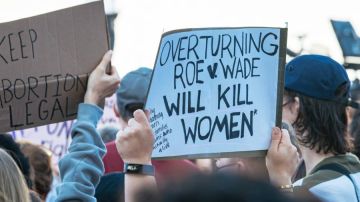Overturning Roe v. Wade Directly Impacts Marginalized Communities
On June 24 the Supreme Court overturned Roe V

Photo by Gayatri Malhotra on Unsplash
On June 24 the Supreme Court overturned Roe V. Wade, the 1973 landmark decision that officially stated that the U.S. protected a pregnant person’s right to choose an abortion. This means that abortion is no longer protected on a national level, instead, the decision grants each state the power to make abortion laws. With the reversal of Roe V. Wade, more than half the states have either banned or threatened to ban abortions so far. Despite 59 percent of Americans supporting the right to choose, the U.S. has taken an enormous step backward for the rights of birthing people and people of color are going to be disproportionately affected.
“Black and brown communities face structural barriers that place them at a significant disadvantage when seeking care, including less access to jobs with a just salary, paid days off, insurance coverage, affordable housing, and childcare, and these obstacles further limit their opportunities to find time-sensitive abortion care,” Khenia Haro-Perez, Virginia State Policy Advocate for the National Latina Institute for Reproductive Justice (NLIRJ) previously told HipLatina
In response to the overturning of Roe v. Wade, an old video of diversity educator Jane Elliott began circulating on social media where she discusses the effects of closing Planned Parenthood locations and ending abortion rights. Elliott shares that criminalizing abortion may be a tactic to prevent the white race from becoming the minority in America. Elliot references the book Birth Dearth by neoconservative Ben Wattenberg who explicitly describes how to maintain the white race as the majority. The plan, Wattenberg explains, is to decrease immigrants who are people of color, pay only white women to have babies, and reduce the number of abortions by white women in America. While this is not related to the decision by the Supreme Court, it brings to light the dire effects of the decision and the result of having a conservative, majority-white Supreme Court. Three of the conservative Justices were nominated by Donald Trump — Associate Justices Neil Gorsuch, Brett Kavanaugh, and Amy Coney Barrett. Conservatives have a 6-3 majority in the Supreme Court for the first time since the Roosevelt administration in the 1940s. Liberal Justices Stephen Breyer, Sonia Sotomayor, and Elena Kagan were in dissent.
A lack of representation and diversity on the Court means those in power are making decisions that impact communities they are not a part of. According to 2019 data from the Centers for Disease Control and Prevention (CDC), the abortion rate for Black women was 23.8 per 1,000 women and 11.7 per 1,000 for Latinas, while it was 6.6 per 1,000 for white women.
“When abortions are criminalized, the communities of people of color are targeted, investigated, and imprisoned. We see a higher number of arrests of young people. And, unfortunately, now there can be charges of murder. We’ve seen the repercussions of banning abortion as very harmful to the family dynamic. Those with financial privileges will be able to access abortion care. This affects our communities negatively and doesn’t affect those with money as much. There is also the aspect of communities of color living with lower wages and, usually, also lack healthcare,” Aurelie Colon Larrauri, a Florida policy advocate for the NATIONAL LATINA INSTITUTE FOR REPRODUCTIVE JUSTICE, tells HipLatina.
A 2013 Journal of Health Politics, Policy and Law report that looked into the arrest of 413 women from 1973-2015 noted that most women being policed during their pregnancy were low-income and that more than half of the women arrested were women of color. In fact, the majority of women who get abortions are below the federal poverty line, are already mothers, and are in their 20s but criminalizing abortions will impact women of color disproportionally, who are more than likely to be affected by the lack of safe access to the procedure. Those who can afford it will be able to travel to a state where it’s legal but for those who can’t afford to pay for travel, room and board, and the procedure, deciding to terminate a pregnancy now comes with legal and health risks.
A few days after the decision, an Instagram post went viral about a woman with an ectopic pregnancy going to a hospital in a state where the trigger laws went to effect immediately and she waited hours to get her procedure done. Why? The doctor was working with a lawyer trying to figure out how to work around the law so as to not lose his license. This, unfortunately, won’t be the only example and for people of color who might need the same treatment and can’t travel to a state where abortion is legal, it could be deadly if they go untreated.
“We know that Latinas, especially immigrant, disabled and low-income communities are targeted by disinformation campaigns and anti-abortion crisis pregnancy centers, and are often at a disadvantage when it comes to accessing the health care they need including abortion. We also know that despite this decision, Latinas/xs/es, like other populations, will continue to seek abortions,” Susy Chávez Herrera
communications director for the California Latinas for Reproductive Justice (CLRJ) tells HipLatina.
Abortions can and do save lives. A birthing person who chooses to have an abortion to terminate a wanted or unwanted pregnancy that puts their life at risk can only survive if they have the freedom to be able to have an abortion. An ectopic pregnancy, for example, often requires an abortion to save the mother’s life. In the case of an ectopic pregnancy, the fetus can only survive outside of the uterus for a few weeks before it succumbs, but if the pregnancy is not terminated, it will result in the mother’s death. If an expecting mother receives a heartbreaking diagnosis about her very-wanted baby’s 0 percent survival rate, she is expected to carry that fetus to term despite endangering the mother. Victims of rape, human trafficking, or incest are equally likely to carry the pregnancy to term if they live in a state where it’s illegal and they can’t afford to travel.
Some of the barriers Latinas/xs can face include language, transportation, knowledge of services and resources, and finances. This impact of this decision reflects a pattern of laws that affect not only Latinas/xs but marginalized communities. “Overturning Roe has only ever been about policing our bodies and controlling the most marginalized folks in our communities and it is BIPOC communities, LGBTQIA+ people, and folks who are disabled who bear the brunt. In the past year, we have seen a slew of violent laws passed that attack reproductive rights, queer and trans families, immigrants, young people, and people with disabilities, this is not a coincidence, these are all connected,” Chávez Herrera says.
In the face of this attack on reproductive rights, people have gathered in the fight against this injustice and that mobilization is what can make a difference. Even in states like California where abortion remains legal, it’s crucial to continue to provide resources, information, and support for those in need. In 2017, there were 1,587 facilities providing abortion in the United States, a 5 percent decrease from the 1,671 facilities in 2014, according to data from the Guttmacher Institute. That will only continue to decrease now that Roe v. Wade has been overturned. Access and information are crucial now more than ever as well as supporting reproductive rights/justice organizations and local abortion clinics.
“We know that the repeal of Roe will have grave consequences on the lives of so many folks in our communities. Yes to grieving, yes to releasing, yes to crying, raging, but we cannot despair,” Laura Jiménez, CLRJ Executive Director tells HipLatina. “This is a time to reimagine, sow seeds, and build anew. Roe was never enough. Organizations, as well as communities, will continue to work on the ground and lead the way, continuing to build systems of community care. We are going to get through this together. We have before and we will now.”
Additional reporting by Virginia Isaad

















